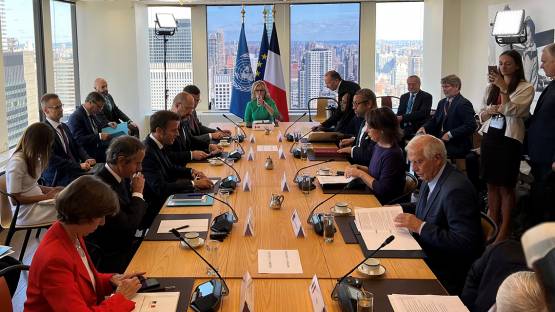An IAEA proposal to establish a nuclear safety and security protection zone around Ukraine’s Zaporizhzhya Nuclear Power Plant (ZNPP) is receiving strong international support and detailed talks have now begun with Ukraine and Russia aimed at agreeing and implementing it as soon as possible, Director General Rafael Mariano Grossi said today after a series of high-level meetings in New York this week.
In a sign of growing momentum for such a zone to protect Europe’s largest nuclear power plant, French President Emmanuel Macron yesterday hosted an event in New York to discuss the safety and security of civilian nuclear facilities in armed conflicts that was also attended by Ukrainian Prime Minister Denys Shmyhal, EU High Representative for Foreign Affairs Josep Borrell as well as foreign ministers and senior officials from several other countries.
After the meeting, chaired by President Macron and Director General Grossi, a statement was issued by nine countries welcoming this month’s IAEA Support and Assistance Mission to Zaporizhzhya (ISAMZ) and supporting the Agency’s efforts to maintain a continued presence there. It also welcomed the Director General’s work to follow up on his mission to the plant on 1 September as well as the proposals made in a report he issued soon thereafter, which include the recommendation for a nuclear safety and security protection zone around the ZNPP.
The statement was issued by senior representatives of the following countries: Canada, France, Germany, Italy, the Republic of Korea, Switzerland, the United Kingdom, the United States, and Ukraine, and the EU’s High Representative for Foreign Affairs and Security Policy.
They also underscored the importance of the seven indispensable nuclear safety and security pillars outlined by the Director General early during the conflict in Ukraine.
Thanking them for their strong backing, Director General Grossi said a nuclear safety and security protection zone must urgently be implemented around the ZNPP, which is held by Russian forces but operated by its Ukrainian staff. The Director General led an IAEA team of safety, security and safeguards experts to the ZNPP three weeks ago. Two ISAMZ members remain there, providing independent, technical observations and assessments and helping to stabilize the situation.
Further underlining the need for such a zone, there has been renewed shelling at the ZNPP site this week, damaging electrical cables and temporarily forcing one of the six reactor units to rely on emergency diesel generators.
“I’m extremely grateful for President Macron’s initiative to hold this important event on the sidelines of the United Nations General Assembly, and I’m very encouraged by the broad support the IAEA’s proposal has received. I’m increasingly confident that the safety and security protection zone will become reality very soon. It is urgently needed. I will spare no effort to make it happen,” he said.
While in New York, Director General Grossi separately also met with Russian Foreign Minister Sergei Lavrov and Ukrainian Foreign Minister Dmytro Kuleba, as part of talks with all parties aimed at reaching an agreement soon on the zone’s establishment.
The Director General first proposed such a zone in a report issued a few days after his mission to the ZNPP, saying shelling there over the past several weeks represented a “constant threat to nuclear safety and security with potential impact on critical safety functions that may lead to radiological consequences with great safety significance.” In the report, he said “shelling on site and in its vicinity should be stopped immediately to avoid any further damages to the plant and associated facilities”. This required “agreement by all relevant parties to the establishment of a nuclear safety and security protection zone around the ZNPP”.






